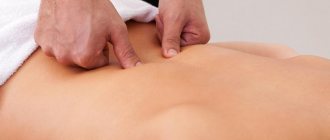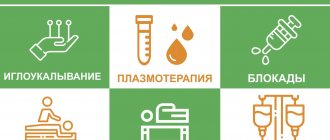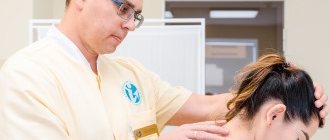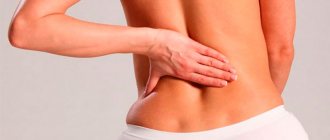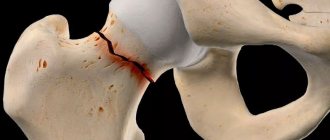The leading symptoms of uncovertebral arthrosis are pain in the cervical spine, dizziness, visual disturbances, and surges in blood pressure. Treatment of the pathology is predominantly conservative. Analgesics, chondroprotectors, muscle relaxants are used, physiotherapeutic and massage procedures are carried out. Daily gymnastics and physical education are especially effective in the treatment of uncovertebral arthrosis.
The concept of uncovertebral arthrosis
Uncovertebral arthrosis
– this is a lesion of intervertebral tissues, leading to loss of functionality of the cervical spine, in the absence of proper treatment, causing loss of mobility and disability.
The key danger of this type of arthrosis is pinching of the spinal roots
, leading to such unpleasant consequences as:
- deterioration in the conduction of nerve impulses;
- insufficient tissue nutrition;
- loss of sensation;
- loss of a number of reflexes.
The presence of the disease has a direct impact on the intensity of vascular activity.
Pathogenesis of the disease
At the initial stage, as a rule, the disease is diagnosed on the C3 – C7 vertebrae.
The disease primarily affects the intervertebral disc. A disc made of cartilage tissue acts as a kind of “shock absorber” between nearby vertebrae. This softens the load when moving. As pathology develops, this tissue is destroyed. Consequently, the vessels, muscles and nerve connections that are located close to the vertebra are not protected during movements.
As the disease progresses, intervertebral tissue loses its properties. Simultaneously with this process, osteophytes (bone formations) begin to grow. Due to the increasing process of calcification, the spine loses its mobility and begins to bend, forming a “hump.” Such deformations not only limit movement, but also compress nerve canals and blood vessels. As a result, the symptoms of the disease develop even more. The greatest likelihood of compression of the neurovascular bundle occurs in patients who have a history of uncovertebral arthrosis of C5 and C6. It is very difficult to restore normal joint function at this stage.
Probable causes of the development of uncovertebral arthrosis
According to available data, among the most likely causes of uncovertebral arthrosis, it is customary to note the following:
- developmental anomalies (presence of Oljenik's symptom/developmental disorders of the cervical spine/lower extremities);
- poor posture;
- professional characteristics;
- inactivity, excess body weight;
- metabolic disorders;
- presence of problems in the functioning of the endocrine system;
- consequences of central nervous system diseases;
- dystrophy of the muscular frame of the cervical spine.
It is worth noting that despite the level of development of modern medicine, there is idiopathic uncovertebral arthrosis
– a type of pathological process, in conditions of progression of which it is impossible to determine the most probable prerequisites for the pathology.
Two types of pathology
Uncovertebral arthrosis can be:
- Deforming - bone spines grow along the edge of the uncinate processes, lengthen and sharpen them (deform).
- Sclerosing - the bone tissue of the uncinate processes becomes denser, they become more massive, and bone osteophytes grow mainly along the edge of the vertebral body.
Click on photo to enlarge
The symptoms of pathology in both varieties are identical.
Symptoms of uncovertebral arthrosis
Studying the main subtleties and nuances of the development of the disease, it is worth highlighting the existence of a sufficiently large number of symptoms and signs of uncovertebral arthrosis, which make it possible to quickly diagnose the pathology.
Among the most striking symptoms of the pathological process, it is customary to highlight:
- pain localized in the neck;
- periodic numbness of the cervical region, back of the head or arms;
- stiffness (mainly in the morning);
- increased fatigue;
- decreased sleep quality;
- atrophy, muscle dystrophy at the site of pathology.
Note that any manifestation of such a symptom of uncovertebral arthrosis as pain occurs mainly as a result of physical activity
, for example, after active turns of the head.
At later stages of pathology progression, a symptom or sign of uncovertebral arthrosis occurs, such as the formation of additional joints formed by overgrown bone tissue (osteophytes), which is formed to distribute the load in the cervical region.
Signs and symptoms of the disease
At the initial stage of development, uncovertebral arthrosis is asymptomatic. Moderate pain occurs only with excessively sharp turns of the head. The rest of the time, the pathology manifests itself as mild discomfort due to reflex tension of the neck muscles. Gradually the pain intensifies and becomes constant. They also occur at night, causing insomnia and deterioration of a person’s psycho-emotional state. In later stages of arthrosis, due to a decrease in the distance between adjacent vertebrae, compression of blood vessels and spinal roots is observed.
Specific symptoms of the disease appear:
- dizziness, headache;
- visual disturbances - temporary decrease in visual acuity, double vision of objects, flashing spots and circles before the eyes;
- hearing disorders - tinnitus, feeling of fullness;
- sudden changes in blood pressure;
- soreness, feeling of a “lump” in the throat.
Due to compression of the vertebral artery by the displaced disc and osteophytes, insufficient oxygen reaches the brain. And infringement of the spinal roots leads to innervation disorder. Clinically, this can manifest itself as panic attacks, increased heart rate, sweating, and impaired coordination of movements.
Stages of uncovertebral arthrosis
Considering the features of degenerative-dystrophic processes localized in the cervical spine, we can distinguish four stages of pathology development:
Stage I
– average degree of tissue destruction of the intervertebral discs, loss of shock-absorbing effect, compensated by excessive tone of the muscle frame, accompanied by stiffness and pain.
Stage II
– loss of stability of the spinal column due to thinning of the cartilage tissue, which provokes subluxations and the formation of protrusions.
Stage III
- narrowing of the gap between the vertebrae leads to pinching of blood vessels, nerves and causes injury to adjacent muscle tissue.
The likelihood of developing serious, irreversible complications is increased. Stage IV
- the progress of the disease provokes the formation of a large amount of bone tissue, which causes not just limitation, but complete immobility of the cervical spine, accompanied by mild pain.
How to treat pathology
Therapy for uncovertebral arthrosis is aimed at eliminating pain, optimizing the load on the spine and preventing further progression of the disease. An integrated approach to treatment is practiced with the simultaneous use of all conservative methods that mutually enhance each other’s effects.
Drug treatment of arthrosis
Non-steroidal anti-inflammatory drugs (NSAIDs) are most in demand in treatment. These drugs quickly eliminate pain and swelling, stop inflammation, which often develops after injury to soft tissues by osteophytes. NSAIDs are included in therapeutic regimens in various dosage forms. These are Fastum, Voltaren, Artrosilene gels, Celecoxib, Etoricoxib, Nise tablets, solutions for parenteral administration Movalis, Diclofenac, Xefocam. The patient may also be prescribed the following medications:
- muscle relaxants Tolperisone, Tizanidine, enhanced by the anesthetic Mydocalm;
- means for improving blood circulation Trental (Pentoxifylline), Nicotinic acid;
- preparations with B vitamins - Milgamma, Combilipen, Neuromultivit;
- ointments with a warming effect - Capsicam, Viprosal, Finalgon.
If NSAIDs are ineffective, uncovertebral joint blockades are performed with glucocorticosteroids and anesthetics. To partially restore damaged cartilage tissue and improve metabolism, chondroprotectors are used - Artra, Chondroxide, Teraflex, Dona. After 2-3 weeks of course use, their pronounced analgesic effect also appears.
Physiotherapeutic procedures
During relapses of arthrosis, patients are shown ultraphonophoresis with Hydrocortisone, ionogalvanization with Lidocaine or Novocaine, electrophoresis with analgesics, anesthetics. To increase the body's sensitivity to drug treatment, magnetic therapy, laser therapy, and modulated currents are used. Outside of an exacerbation, to improve the patient’s well-being and prevent relapses, the following physical procedures are performed:
- amplipulse - therapeutic effect of alternating modulated current;
- diadynamic currents - treatment with current in the form of a half-sine wave of constant strength up to 30 mA and low frequency 50-100 Hz;
- Ultrasound - exposure to low-intensity, high-frequency sound vibrations.
Applications with paraffin and ozokerite, and hirudotherapy are also used. The impact of physical factors on the cervical spine helps to accelerate the blood supply to bone and cartilage structures with nutrients and prolong remission.
Orthopedic treatment
In the acute and subacute period, patients with uncovertebral arthrosis are recommended to wear Shants collars for up to 4 hours daily. Orthopedic devices are used to reduce the load on injured vertebral structures of the cervical spine. They prevent the displacement of discs and osteophytes, and prevent compression of blood vessels and nerve roots. For patients with pathology of 3-4 degrees of severity, wearing Shants collars is also indicated in remission.
Massage
Massage procedures for uncovertebral syndrome should be performed only by a specialist with a medical education who is familiar with the anatomy of the cervical spine. He works with his hands on the muscles, relaxing them through stroking, kneading, rubbing, and vibration. Neurologists recommend that patients visit a massage room 2-3 times a year to prevent relapses.
Physiotherapy
This is the most effective, affordable method of treating pathology. Exercises are selected by a physical therapy doctor individually for each patient, taking into account the severity of degenerative changes in joints, discs, and vertebrae. Usually they are recommended to rotate their head in a circular motion, tilt it and turn it to the sides. Movements should be low-amplitude, smooth, slow. After about a month of daily exercise, there is a decrease in pain and an increase in the range of motion in the cervical spine.
Operation
Indications for surgical treatment include compression of the spinal canal, persistent pain, and severe stiffness that cannot be eliminated by conservative methods. Surgeries are also performed in case of rapid progression of uncovertebral arthrosis. The most commonly used is decompression laminectomy followed by stabilization of the vertebral bodies.
Spa treatment
At the stage of remission, patients are recommended to undergo sanatorium-resort treatment in Kislovodsk, Pyatigorsk, Essentuki. In specialized medical institutions, treatment methods are used aimed at strengthening the body's defenses, improving the functioning of not only the musculoskeletal system, but also internal organs. Sanatoriums use mud wraps, table mineral waters, radon, pearl, carbon dioxide, and hydrogen sulfide baths.
ethnoscience
None of the folk remedies can slow down the destruction of uncovertebral joints. Ointments, compresses, and alcohol tinctures are also ineffective in eliminating pain, inflammatory swelling, and stiffness of movement. Therefore, neurologists allow them to be used by patients only after the main treatment to prevent relapses.
Diagnosis of uncovertebral arthrosis
Before starting treatment for uncovertebral arthrosis, it is important to correctly diagnose it and determine the stage of development of pathological processes
.
A thorough diagnosis of the pathological condition allows us to clarify the picture of the disease. The only most effective method for studying the problem is high-field magnetic resonance imaging (MRI)
.
There is simply no alternative to the diagnostic method. However, there are cases when computed tomography (CT)
with the use of a contrast agent in combination with a number of laboratory tests and observation of the patient in a hospital setting.
Treatment of uncovertebral arthrosis
The treatment of uncovertebral arthrosis is based on the following principles:
- pain relief;
- decreased muscle tone;
- blood flow stabilization;
- improvement of metabolic processes occurring in brain tissue;
- muscle stimulation.
To achieve the most effective results, taking into account the existing clinical picture, the use of various types of therapy is recommended. Let's look at some of them in more detail.
Pharmacotherapy
Treatment of uncovertebral arthrosis of the cervical spine using medications
– the basis of therapeutic treatment related to conservative methods.
chondroprotectors are widely used
, as well as
NSAIDs
-
non-steroidal anti-inflammatory drugs
, including
Artradol
. In particularly advanced cases, it is recommended to combine them with steroids, which can reduce pain and relieve inflammation.
In addition, effective means of helping to relieve pain are drugs such as analgesics and antispasmodics, the selection of which is carried out taking into account the characteristics of the existing clinical picture.
In the process of treating uncovertebral arthrosis with drugs, drugs of various forms (tablets/capsules, gels or injections) can be used.
Physiotherapy and other techniques
Physiotherapy
is a separate area of medicine that prefers exclusively natural or artificially created physical factors as treatment and prevention.
The use of physiotherapeutic techniques makes it possible to reduce the number of medications used and at the same time improve the effect of their use.
Existing physiotherapeutic methods used to treat uncovertebral arthrosis can significantly alleviate the patient’s condition. Among the most effective methods of physiotherapeutic treatment, it is customary to highlight the following:
- ultrasound/magnetic field therapy;
- electrophoresis with the use of drugs;
- mud therapy;
- wraps using paraffin;
- compresses using saline solution;
- massages and a complex of manual therapy.
IMPORTANT! The use of physiotherapeutic treatment is possible only during the period of remission, in order to consolidate the effect of the use of medications.
Nutrition
The basis of treatment of uncovertebral arthrosis is complex therapy
. One of its components is dietary nutrition, which involves following a non-strict diet, the key limitation of which is reducing the amount of table salt consumed.
Throughout the entire treatment, as well as during the period of remission, the patient’s menu should be as varied as possible. It is important to enrich your diet with vitamins and minerals.
In addition, it is important to get rid of bad habits and normalize the water balance in the body, which contributes to the effective restoration of cartilage tissue.
It is also worth noting that the clinical features of the disease do not allow patients to adhere to the basics of a vegetarian diet.
Possible complications and consequences
Like any other pathological process, uncovertebral arthrosis of the cervical, in the absence of necessary therapeutic measures, can lead to complications and irreversible consequences that can arise as a result of illiterate diagnosis
or
lack of proper treatment
.
Among the most likely complications, it is worth paying attention to the following:
- decreased level of mobility;
- pain of varying degrees of intensity;
- visually noticeable deformation, the occurrence of hernia and protrusions;
- violation of metabolic processes;
- stroke;
- periodic fainting;
- instability of psycho-emotional state.
Causes of the disease
Deformation of the cervical joints is associated with the following reasons:
- Previous injuries and damage to the cervical spine. Injuries can vary, including sprains, falls and severe injuries.
- Congenital anomalies in the structure of the joints of the cervical vertebrae.
- The presence of age-related osteoporosis or degenerative cervical osteochondrosis.
- Less common causes are long-term deficiency of certain vitamins and minerals. Particularly detrimental to bones is a deficiency of calcium, cholecalciferol, magnesium and zinc.
- Endocrine disorders, malabsorption syndrome, and metabolic disorders have a negative impact on the health of the musculoskeletal system.
- Presence of arthritis.
What factors in the development of the disease are provoking:
- Physical inactivity or excessive physical activity. An example is a sedentary lifestyle with little movement or professional sports.
- Constant sedentary work in an uncomfortable position.
- Age-related degenerative changes. After 40-50 years, natural aging of tissues is observed. The rate of development of degeneration is also related to the patient’s heredity and lifestyle.
Forecasts
The decisive factor in the prognosis for uncovertebral arthrosis is the early diagnosis of pathological processes.
The timely start of the fight against pathological processes allows us to talk about the success of the applied set of procedures. In 80% of the cases studied, a combination of drug and non-drug therapy helps to achieve positive results in the shortest possible time. In the remaining 20% of cases, the problem of pathology development is solved with the help of the professionalism of neurosurgeons.
Prevention
The best treatment for any disease is its prevention, preferably before the first symptoms appear.
The most effective methods of preventing uncovertebral arthrosis and a number of other diseases of similar etiology is maintaining a moderately active lifestyle.
Remember that human health is the most valuable wealth, the replenishment of which is not at all easy.
Avoid self-medication and, when the first signs of pathological processes develop, seek qualified medical help.
.
